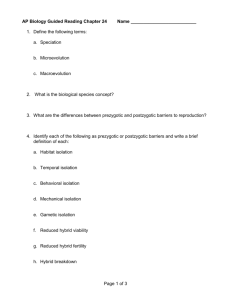speciation
advertisement

AP BIOLOGY Evolution Activity #5 SPECIATION SPECIES REPRODUCTIVE BARRIERS: PREZYGOTIC BARRIERS: POSTZYGOTIC BARRIERS: Evolution Activity #5 Page 1 of 8 MODE OF SPECIATION ALLOPATRIC Evolution Activity #5 Page 2 of 8 SYMPATRIC GENETIC CHANGE SPEED OF SPECIATION GRADUALISM Evolution Activity #5 Page 3 of 8 PUNCTUATED GRADUALISM QUESTIONS 1. What happens during the process of speciation? 2. List the two patterns of speciation and describe each type. 3. How are prezygotic and postzygotic barriers different? 4. Use the key below to identify the type of reproductive barrier being described. a. Habitat isolation b. Temporal isolation c. Behavioral isolation d. Mechanical isolation e. Gametic isolation _____ Gametes fail to fuse _____ Egg & sperm don’t recognize each other _____ Differences in sexual or anatomical structures _____ Mating dance of a male not recognized by female _____ Different mating seasons within the population _____ Members of population separated by a mountain range _____ Male flowers of some members of a plant species produce pollen before most of the female flowers are open _____ Variation in mating ritual not recognized by female _____ Male reproductive organs in insect populations vary enormously in size and shape, preventing the effective transfer of sperm to females of different species _____ Structure of flower restricts access of insects without specific physical and behavioral adaptations Evolution Activity #5 Page 4 of 8 5. Match the type of postzygotic barrier with the correct description. a. Hybrid breakdown b. Hybrid inviability c. Hybrid sterility _____ Zygote fails to develop; fails to reach sexual maturity _____ Hybrid fails to produce functional gametes _____ Offspring not viable or infertile; offspring of hybrid have reduced viability or fertility 6. Identify the type of reproductive barrier illustrated by the following examples and indicate whether they are pre- or postzygotic barriers. Example Two lab species of frogs are mated in the lab and produce viable, but sterile offspring Two species of sea urchin release their gametes at the same time, but crossspecific fertilization does not occur Two species of orchid have different length nectar tubes and are pollinated by different species of birds Two species of mayflies merge during different weeks in springtime Two species of salamanders will mate in the lab and produce, viable, fertile offspring, but offspring of the hybrids are sterile Two similar species of birds have different mating rituals When two species of mice are bred in the lab, embryos usually abort Peepers breed in woodland ponds, whereas leopard frogs breed in swamps Evolution Activity #5 Page 5 of 8 Type of Barrier Pre- or Post- 7. The result of a cross between a donkey and a horse is a mule. Mules are usually sterile. What type of reproductive barrier does this represent? How do you know? Based on these results, would you say that the donkey and horse belong to the same species or to different species? Explain your answers. 8. What are the limitations of the biological concept of a species? 9. Match the species concept with the correct description. A. Biological B. Cohesion C. Ecological D. Evolutionary E. Morphological F. Recognition _____ Defines species on the basis of the ecological role they play and the specific environment in which they live _____Population of group of populations whose members have the potential to interbreed and produce fertile offspring _____Focuses on adaptations that maximize successful mating within a species that enable individuals to recognize a mate and that can be acted on by natural selection _____ Based on measurable physical features; used by taxonomists _____ Emphasizes adaptations that maintain a species identity despite occasional hybridization with another species _____ Defines species in terms of evolutionary lineage and ecological role; populations making up a species are subject to and united by a unique set of selection pressures Evolution Activity #5 Page 6 of 8 10. Two groups of a population are isolated reproductively. What will probably happen over time provided these groups remain isolated from each other? 11. Match the term with the correct definition. A. Adaptive Radiation B. Allopatric speciation C. Endemic Species D. Sympatric Speciation ____ New species arise when a population is segregated by geographic barrier ____ Emergence of numerous species from a common ancestor that spreads into a new environment ____ New species arise within the range of the parent population ____ Species found nowhere else on earth 12. Explain what is meant by sympatric speciation and identify the mechanisms by which it can occur. 13. Explain briefly how polyploidy may cause the formation of a new species. 14. What factors have contributed to the adaptive radiation of the thousands of endemic species on the Hawaiian Archipelago? 15. How is autopolyploidy different from allopolyploidy? Evolution Activity #5 Page 7 of 8 16. Why might sexual selection lead indirectly to reproductive isolation? 17. Why is reproductive isolation so important in the process of speciation? 18. Suggest the kinds of environments that would support the following paces of evolutionary change. a. Punctuated Equilibrium: b. Gradualism 19. Define allometric growth. 20. What effect would a small change in the genetic information controlling allometric growth have on the adult form? Evolution Activity #5 Page 8 of 8








